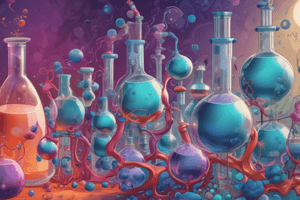Podcast
Questions and Answers
What is the primary method of determining the colligative properties of a substance?
What is the primary method of determining the colligative properties of a substance?
- Measuring the polymer's β transition temperature
- Measuring the osmotic pressure and boiling point elevation (correct)
- Measuring the molecular weight of the polymer
- Measuring the polymer's glass transition temperature
What is the characteristic of a polymer in the glassy state?
What is the characteristic of a polymer in the glassy state?
- Brittle and rigid (correct)
- Semi-crystalline and transparent
- Amorphous and flexible
- Rubbery and flexible
What occurs at the β transition temperature (Tβ) in a polymer?
What occurs at the β transition temperature (Tβ) in a polymer?
- The polymer's crystalline structure is disrupted
- The polymer's molecular chains become free to rotate
- Only side groups in the polymer gain sufficient thermal energy to rotate (correct)
- The polymer changes from a glassy to a rubbery state
What is the result of the molecular chains gaining freedom to rotate at the glass transition temperature (Tg)?
What is the result of the molecular chains gaining freedom to rotate at the glass transition temperature (Tg)?
What is the temperature at which an amorphous polymer changes from a glassy state to a rubbery state and vice versa?
What is the temperature at which an amorphous polymer changes from a glassy state to a rubbery state and vice versa?
What is the characteristic of a polymer in the rubbery state?
What is the characteristic of a polymer in the rubbery state?
What is the primary characteristic of amorphous polymers in the solid state?
What is the primary characteristic of amorphous polymers in the solid state?
What is the consequence of the polymer molecules adopting random coiled conformations?
What is the consequence of the polymer molecules adopting random coiled conformations?
What is the significance of the glass transition temperature (Tg) in a polymer?
What is the significance of the glass transition temperature (Tg) in a polymer?
What is the purpose of measuring colligative properties in a substance?
What is the purpose of measuring colligative properties in a substance?
What is the difference between the β transition temperature (Tβ) and the glass transition temperature (Tg)?
What is the difference between the β transition temperature (Tβ) and the glass transition temperature (Tg)?
What is the common characteristic of all amorphous polymers?
What is the common characteristic of all amorphous polymers?
What is the result of the polymer molecules being unable to move easily in the glassy state?
What is the result of the polymer molecules being unable to move easily in the glassy state?
Flashcards are hidden until you start studying
Study Notes
Colligative Properties
- Measuring colligative properties helps determine certain characteristics
- Examples of colligative properties include freezing point depression, boiling point elevation, osmotic pressure, and lowering of vapour pressure
Glass Transition Temperature
- Amorphous polymers in the solid state are rigid, hard, and transparent like glass (glassy state)
- In the glassy state, molecular chains cannot move easily, making the polymer brittle
- When heated, amorphous polymers undergo two transitions: β-transition temperature (Tβ) and glass transition temperature (Tg)
- At Tβ, side groups in the polymer gain sufficient thermal energy to rotate
- At Tg, segments of the polymer chain (complete blocks of C atoms) gain sufficient thermal energy to rotate as an entity
- At Tg, the polymer's behaviour changes from glassy to rubbery
- In the rubbery state, molecules adopt random coiled conformations due to free rotations about single covalent bonds in the chain backbone
- All amorphous polymers undergo a transition from glassy to rubbery state when heated, and vice versa when cooled, at a definite temperature called the glass transition temperature
Studying That Suits You
Use AI to generate personalized quizzes and flashcards to suit your learning preferences.




